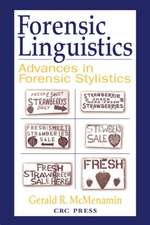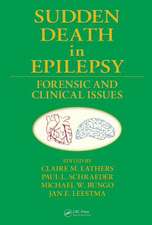Forensic Recovery of Human Remains: Archaeological Approaches, Second Edition
Autor Tosha L. Dupras, John J. Schultz, Sandra M. Wheeler, Lana J Williamsen Limba Engleză Hardback – 27 oct 2011
| Toate formatele și edițiile | Preț | Express |
|---|---|---|
| Paperback (1) | 449.19 lei 6-8 săpt. | |
| Taylor & Francis – 31 mar 2021 | 449.19 lei 6-8 săpt. | |
| Hardback (1) | 875.07 lei 6-8 săpt. | |
| Taylor & Francis – 27 oct 2011 | 875.07 lei 6-8 săpt. |
Preț: 875.07 lei
Preț vechi: 1067.16 lei
-18% Nou
Puncte Express: 1313
Preț estimativ în valută:
167.45€ • 172.75$ • 139.73£
167.45€ • 172.75$ • 139.73£
Carte tipărită la comandă
Livrare economică 27 martie-10 aprilie
Preluare comenzi: 021 569.72.76
Specificații
ISBN-13: 9781439850305
ISBN-10: 1439850305
Pagini: 398
Ilustrații: 198 b/w images and 67 tables
Dimensiuni: 156 x 234 x 23 mm
Greutate: 1.55 kg
Ediția:Revizuită
Editura: Taylor & Francis
Colecția CRC Press
Locul publicării:Oxford, United Kingdom
ISBN-10: 1439850305
Pagini: 398
Ilustrații: 198 b/w images and 67 tables
Dimensiuni: 156 x 234 x 23 mm
Greutate: 1.55 kg
Ediția:Revizuită
Editura: Taylor & Francis
Colecția CRC Press
Locul publicării:Oxford, United Kingdom
Public țintă
Academic and Professional Practice & DevelopmentCuprins
Introduction to Forensic Archaeology. Tools and Equipment. Human Skeletal Terminology. Understanding the Forensic Context. Search Techniques for Locating Human Remains. Methods of Geophysical Survey. Surveying and Mapping Methods. Applying Archaeological Methods in a Forensic Context. Collecting Botanical and Entomological Evidence. Collecting Skeletal Remains. Writing the Final Report. Appendix A: Adult Skeletal Inventory Form (Field Collection). Appendix B: Infant Skeletal Inventory Form (Field Collection). Appendix C: Child Skeletal Inventory Form (Field Collection). Appendix D: Personnel and Scene Summary Form. Appendix E: Recovery Scene Context Form. Appendix F: Surface Deposit Recovery Form. Appendix G: Feature Excavation Form. Appendix H: Remains Summary Form. Appendix I: Forensic Entomology Data Collection Form. Appendix J: Photography/Video Record Form. Appendix K: Evidentiary Inventory Form. Appendix L: Evidentiary Chain of Custody Form. Glossary. Index.
Notă biografică
Tosha L. Dupras, Ph.D. specializes in bioarchaeology, particularly diet reconstruction through chemical analysis, and has been associated with the Dakhleh Oasis and Dayr al Barsha projects in Egypt where she has excavated in several cemeteries and analyzed many skeletal remains. Dupras also assists local law enforcement agencies with the search for and excavation of human remains.
John J. Schultz, Ph.D.’s primary research focuses on forensic and archaeological applications of ground-penetrating radar (GPR) for grave detection, and detection of buried metallic weapons using various geophysical technologies. Schultz is also a consulting forensic anthropologist in the central Florida area for various law enforcement agencies and the local Medical Examiner’s Office.
Sandra M. Wheeler, Ph.D. specializes in bioarchaeology, paleopathology, juvenile osteology, and mortuary archaeology. Wheeler has conducted fieldwork in Belize and Mexico and continues to actively work with the Dakhleh Oasis Project, Egypt. She has assisted law enforcement in Florida and Canada with the search for and recovery of human remains.
Lana J. Williams, Ph.D. specializes in biochemical analysis of human remains, mortuary archaeology, and human osteology. Williams has conducted fieldwork in Greece and Belize and is currently working with the Dakhleh Oasis and Dayr al Barsha projects in Egypt. In addition, she has assisted law enforcement in Florida and Canada in the search, recovery, and analysis of human remains.
John J. Schultz, Ph.D.’s primary research focuses on forensic and archaeological applications of ground-penetrating radar (GPR) for grave detection, and detection of buried metallic weapons using various geophysical technologies. Schultz is also a consulting forensic anthropologist in the central Florida area for various law enforcement agencies and the local Medical Examiner’s Office.
Sandra M. Wheeler, Ph.D. specializes in bioarchaeology, paleopathology, juvenile osteology, and mortuary archaeology. Wheeler has conducted fieldwork in Belize and Mexico and continues to actively work with the Dakhleh Oasis Project, Egypt. She has assisted law enforcement in Florida and Canada with the search for and recovery of human remains.
Lana J. Williams, Ph.D. specializes in biochemical analysis of human remains, mortuary archaeology, and human osteology. Williams has conducted fieldwork in Greece and Belize and is currently working with the Dakhleh Oasis and Dayr al Barsha projects in Egypt. In addition, she has assisted law enforcement in Florida and Canada in the search, recovery, and analysis of human remains.
Descriere
Processing a crime scene where human remains are found presents unique challenges and requires specialized techniques not generally learned in standard crime scene and law enforcement training. This volume is an updated, comprehensive reference pertaining to the search, recovery, documentation, and excavation of human remains and associated evidence from forensic contexts. Highlights include chapters on understanding the forensic context and writing the final report, locating experts, terminology and equipment, surveying and mapping techniques, excavation of buried evidence, and guidelines for distinguishing between human and nonhuman skeletal remains. Case studies and discussion questions facilitate further study.



















